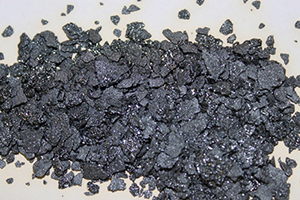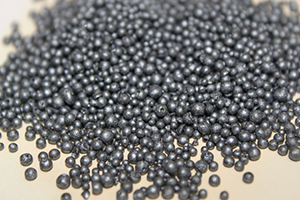Typical iodine production involves a series of chemical reactions known as reduction-oxidation reactions. Oklahoma began producing iodine in 1977 by this method. Figure 2 shows a series of blow-out towers where these reactions take place. The final product is 98% pure iodine flake (Figure 3) or prill (Figure 4), which is extracted from the brine. The waste brine, or effluent, is left over after removing the iodine. The reinjected effluent goes into the same producing formation downstream so that it forces the iodine-rich brines back towards producing wells.
Iodine in Oklahoma
Iodine! Just one more aspect of Oklahoma that makes it unique—the State is the only producer of this essential element in the United States. Oklahoma ranks third in global iodine production behind Chile and Japan. Production wells (Figure 1) drilled to depths between 7,000 and 13,000 feet in ancient river deposits known as the Woodward trench in northwest Oklahoma bring formation waters enriched in iodine (on average greater than 300 parts per million, ppm) to the surface. Produced waters from oil and gas wells in other areas in northern Oklahoma, also contain iodine. Mobile industrial units extract the iodine there before sending the water to disposal wells.


Figure 2. Blowout towers (courtesy IOCHEM Corporation).

Figure 3. Crystals produced as flake (courtesy IOCHEM<br>Corporation).
So, what is iodine? And why is iodine important? The chemical element iodine is a bluish-black, crystalline solid with sub-metallic luster (Figures 3–4 ). It belongs to a class of elements known as the halogens found in Group VIIA on the Periodic Table. At ordinary room temperatures iodine is a blue-violet gas that has an irritating odor. As a solid, iodine readily goes from its solid form to a gas, a process called sublimation.

Figure 4. Crystals produced as prill (courtesy IOCHEM<br>Corporation).
Most of us recognize iodine from the salt shaker that we may use every day. The lack of iodine in the diet can lead to serious disease, the most common is iodine deficiency disease. Two results are goiter and intellectual disability. Goiter, a thyroid condition, can create hormone imbalances. Intellectual disability results from insufficient iodine in the diets of pregnant women and young children. In both cases iodine is necessary for brain development particularly in human embryos. Adding iodine to salt provides a readily-available supplement to the human diet and a way of overcoming iodine deficiency.
Traditional uses of iodine include pharmaceuticals, human and animal feed, germicides, and x-ray contrast media. The new markets for iodine occur in the manufacture of liquid crystal displays (LCDs) and light emitting diodes (LEDs). This is the result of the heavy demand for computer and television screens and the increased use of LED lighting, respectively.
Additional Information
OGS Geologist Stanley Krukowski's latest report on iodine: Iodine, in Industrial Minerals review 2015. Anonymous. Mining Engineering; Littleton 68.7 (Jul 2016): 30-84. (PDF)

